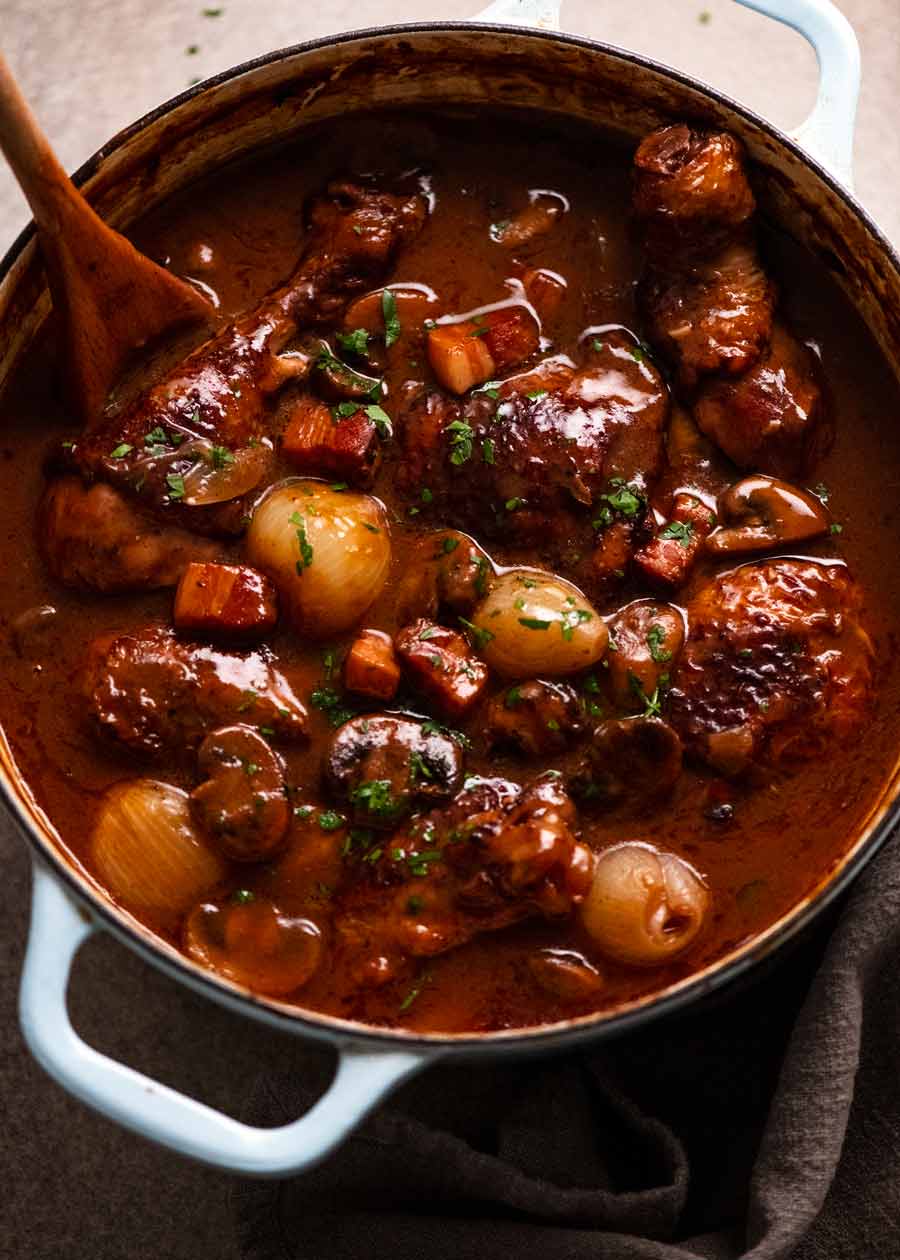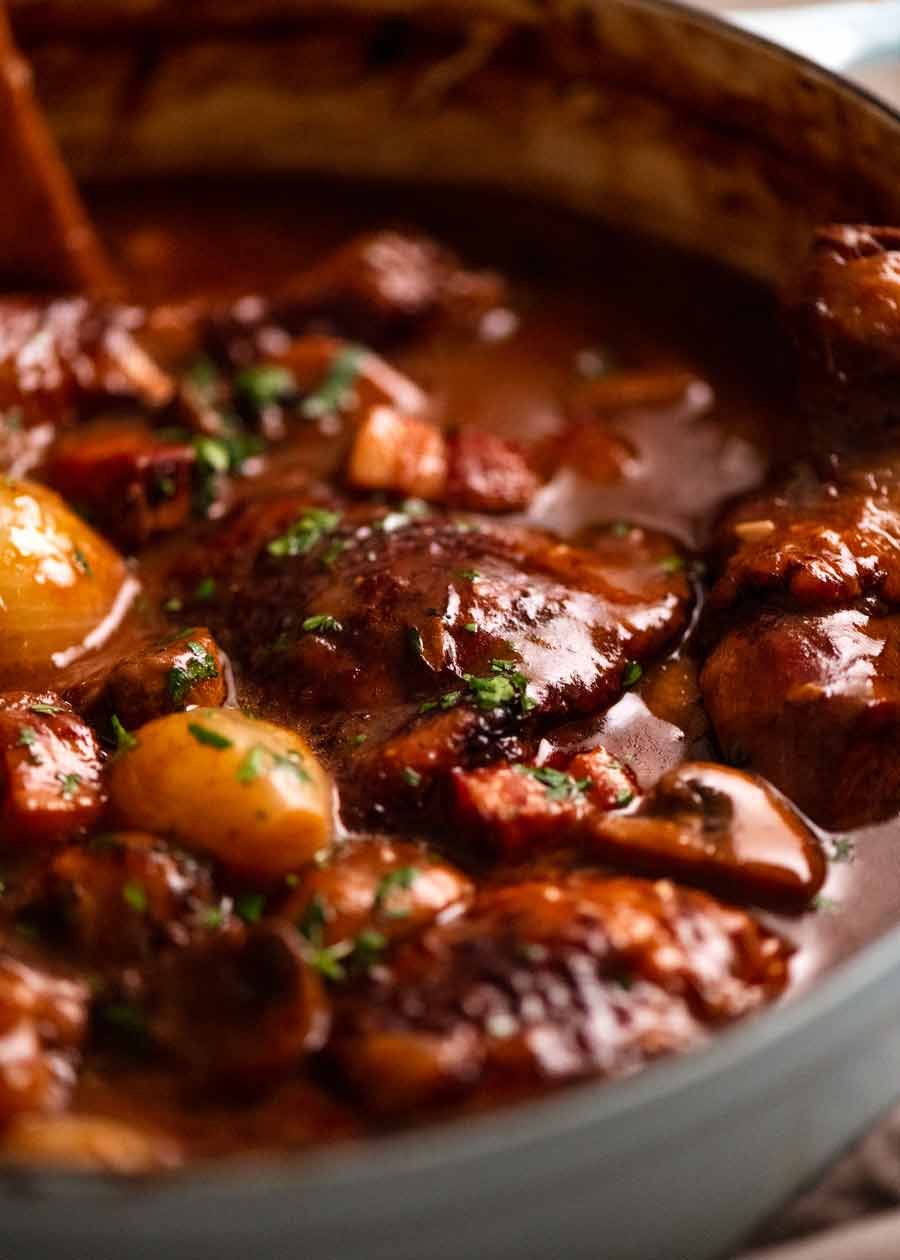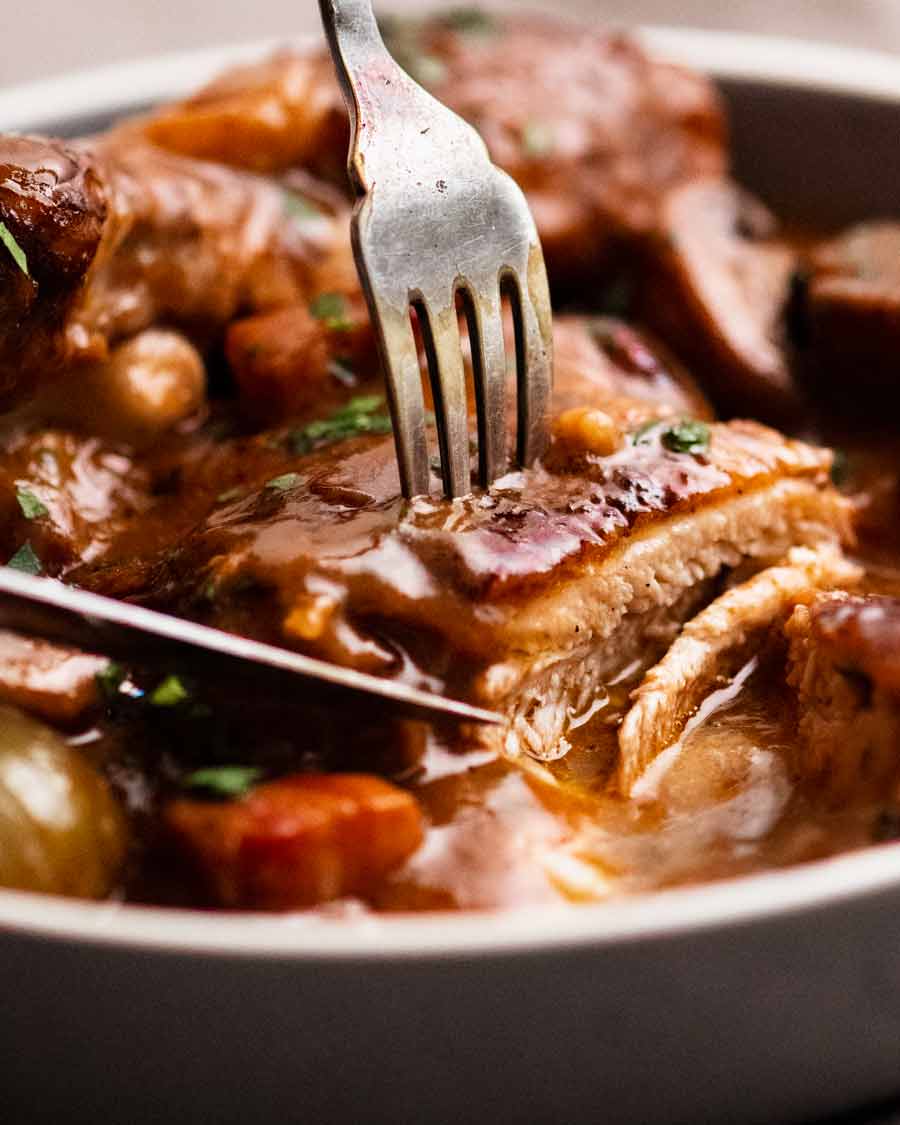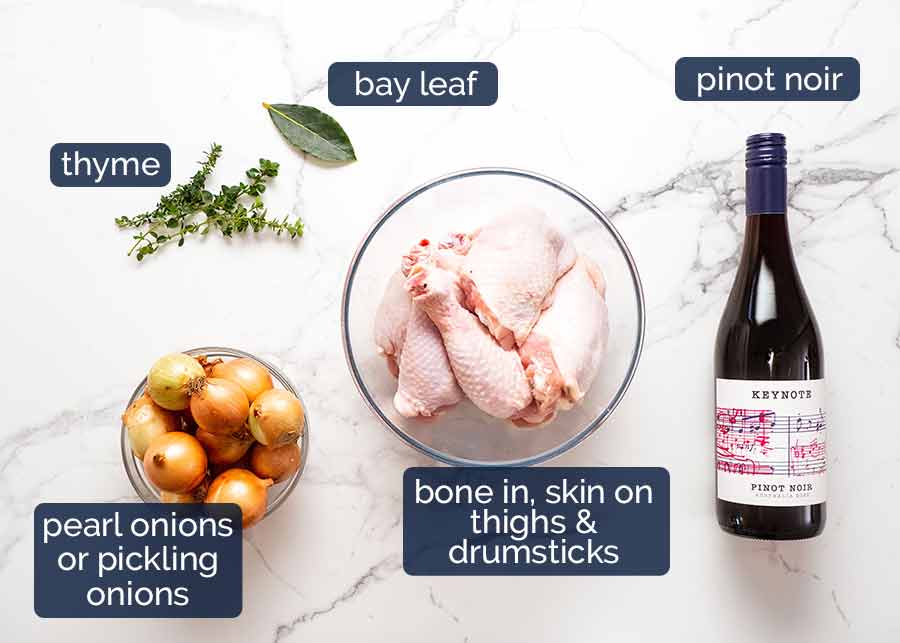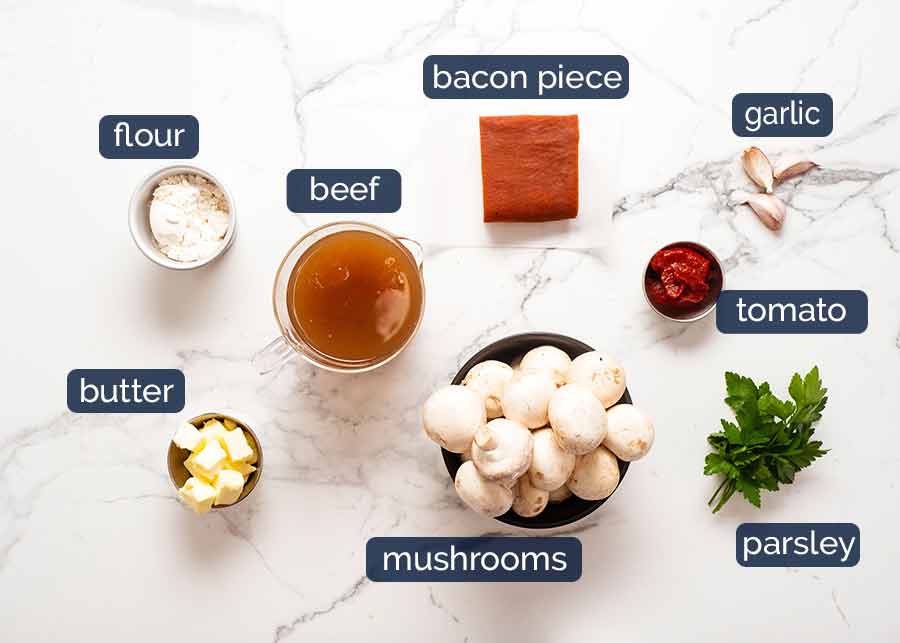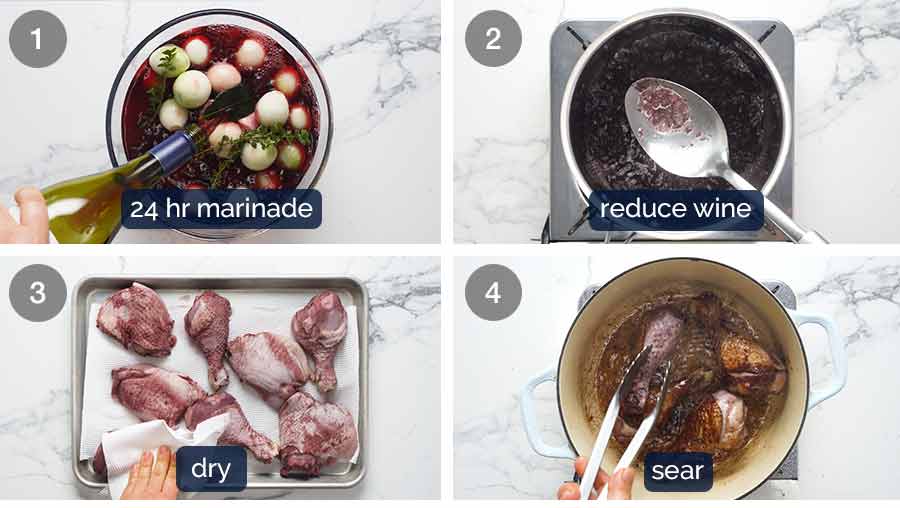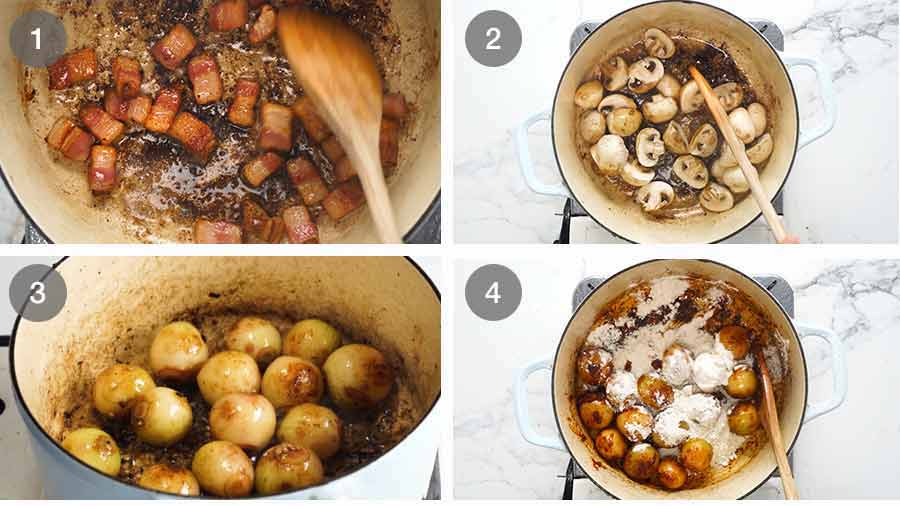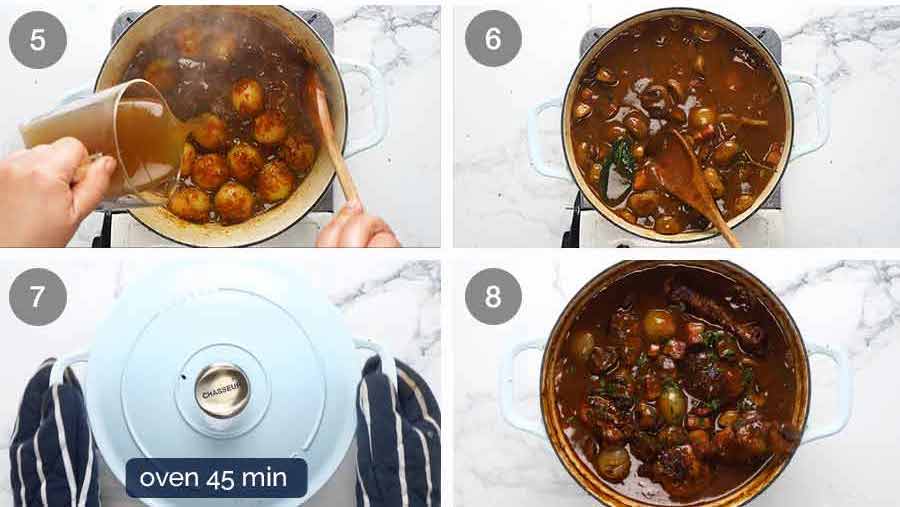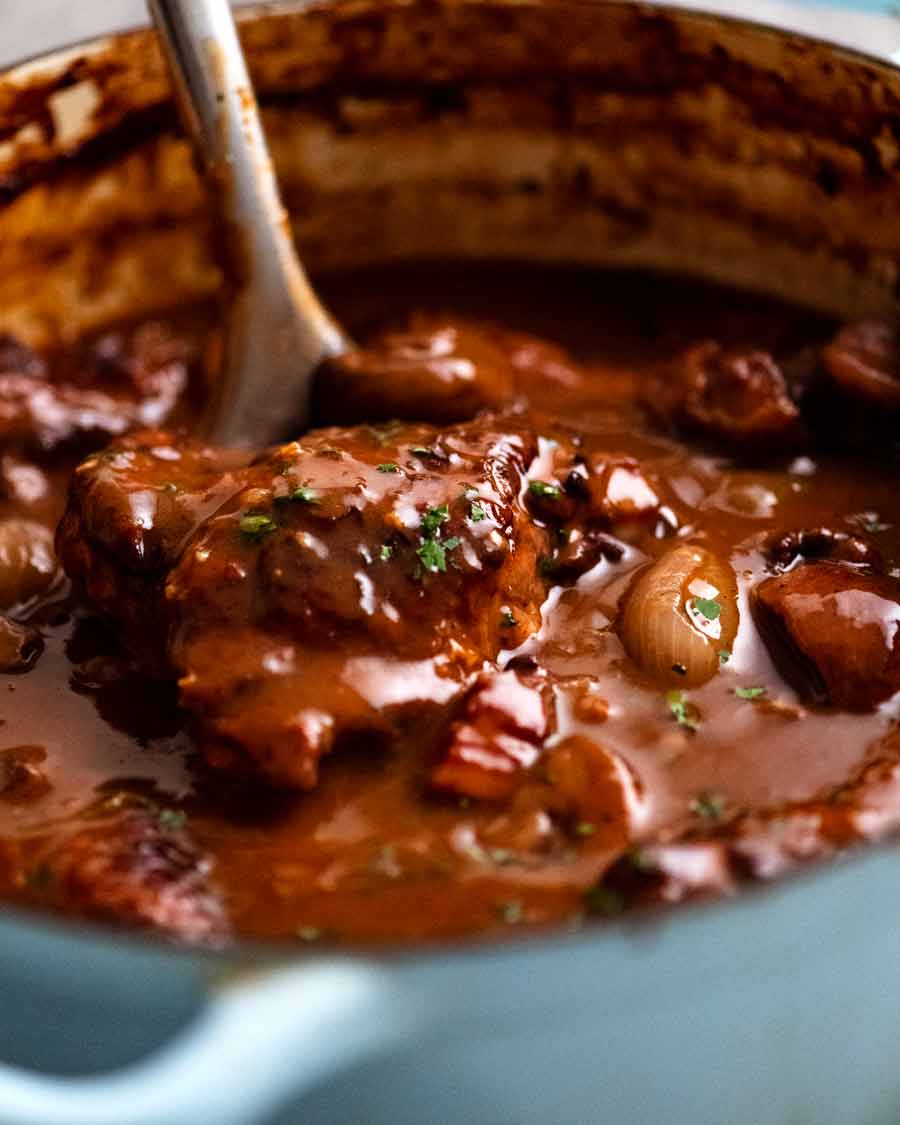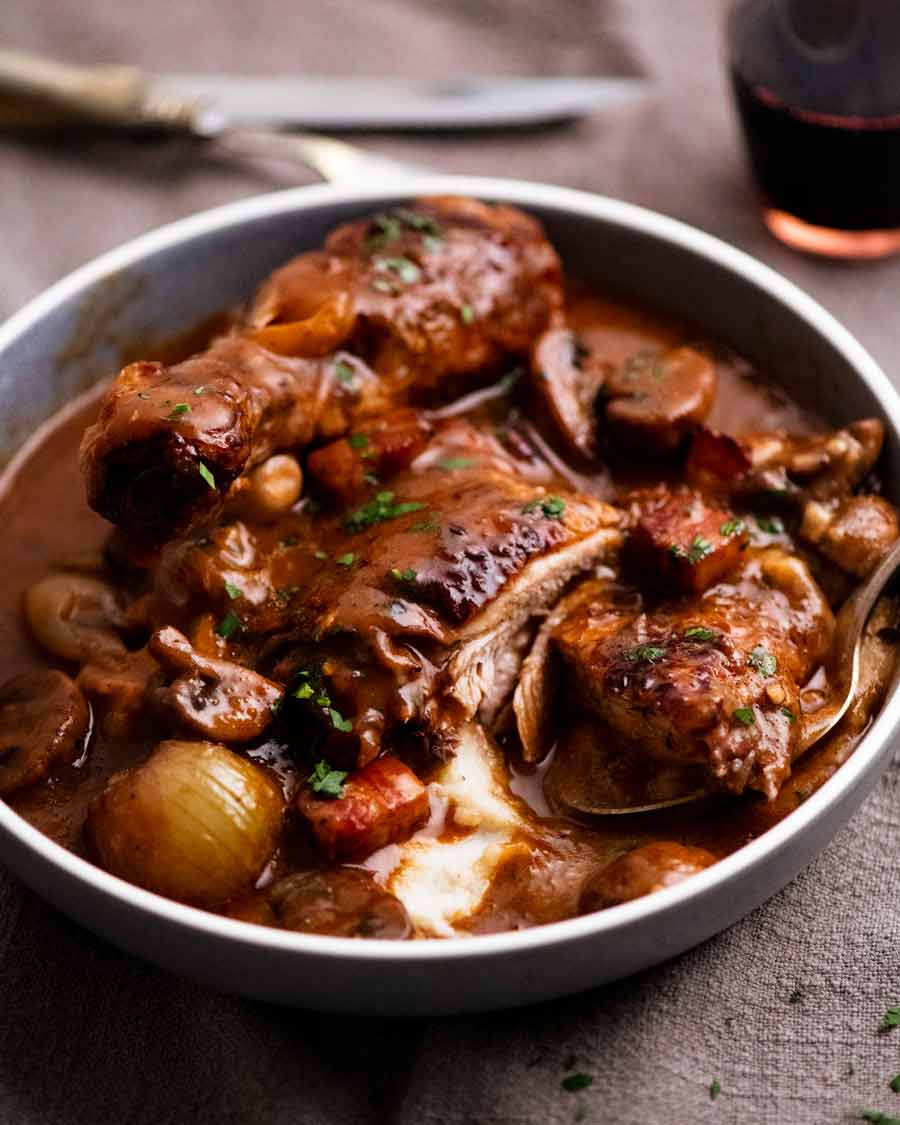Coq au Vin – French chicken stew
Chicken stews are delightful and criminally underrated in my book. Too often they play second fiddle to the divas of the stew world like lamb shanks, braised short ribs and curries. Maybe it’s because chicken as a meat is considered somewhat “common”? As a result, delicious and hardworking dishes like this Everyday Chicken Stew (with crispy skin!) or this weeknight Fast Chicken Stew just don’t get their share of the love they deserve. If there’s any dish that can rise above the image problem that most chicken stews suffer though, it’s got to be Coq au Vin. This French (naturally!) classic is all about succulent bone-in chicken pieces braised in a glossy, alluringly dark and rich red wine sauce. The sauce’s deeply savoury flavour perfumed with herbs and bacon is complex and seems to just linger forever. If I had to call it (and regular readers know I will!), I reckon Coq au Vin is hands down the greatest and certainly the most luxurious chicken stew in the world! Yet there’s actually less ingredients than any of the stews mentioned earlier. The recipe is surprisingly straightforward. Making a great Coq au Vin instead is all about small additional steps and details that add up little by little to weave the magic into this magnificent stew. Trust me: Take the time to make this properly and I promise you’ll never look at chicken stew the same way again!
What you need to make Coq au Vin
1. Chicken and red wine marinade
Here’s what you need to marinate the chicken. The red wine is first used for marinating the meat and later reduced on the stove to make the sauce.
2. For the Coq au Vin
In addition to above, here are the other ingredients that go into the Coq au Vin: Bone-in, skin-on thighs and drumsticks are the safest for the most tender, juicy results. Cutting up your own whole chicken would also be an option (and more traditional). Keep the chicken breast whole with the skin on and bone in. Marinate and sear per recipe but only put it in the pot for the last 20 minutes in the oven (else it will overcook and dry out) Pinot Noir is the traditional wine typically used in Coq au Vin, usually from Burgundy. In France different wine regions showcase their local wines to create variations of chicken-in-wine dishes (sometimes even champagne!). Really though any red variety will do as long as it’s not too heavy and full-bodied – shiraz, cabernet sauvignon, merlot, malbec are all good. Wine quality – Even though wine is the primary flavouring in this dish, there’s still no need to splurge on expensive wine. The old adage that you should “only cook with wine you’d drink” has largely been consigned to the dustbin of culinary myths thanks to modern wisdom, such as from authorities like the New York Times, who found from tests that “the wonderful wines and the awful ones produced equally tasty food, especially if the wine was cooked for more than a few minutes.” The braising time and other flavours works wonders to transform even economical wine – just rummage through the discount bins at your local liquor store. The bottle I used was a $15 one, reduced to $6 (Dan Murphy’s!).
Beef stock is the stock of choice for this dish. That might sound strange for a chicken stew, but it’s what gives it the really rich, dark colour and deeper flavour. Cooked out with all the other ingredients it doesn’t taste beefy at all, because you get so much flavour from the chicken juices. Chicken stock will work fine but the sauce colour won’t be as deep, and the flavour will be a little lighter.Beef stock quality is the key variable here that will set apart a good homemade Coq au Vin from an exceptional restaurant-quality one. Homemade beef stock trumps any store bought. Good quality store-bought from butchers etc. are far better than mass-produced (like Campbell’s here in Australia).Do not use powdered beef stock. It’s frankly inferior to even the packet liquid stock and has no place here amongst all this effort, I’m afraid!Bacon – Get slab bacon from your butcher if you can, so you can cut it yourself into big, chunky lardons (batons). Biting into chunks of meaty bacon lardons as opposed to scrappy small shreds is part of what makes a great Coq au Vin so appealing!If you can’t find slab bacon, try speck (which in Australia is smoked pork belly chunks). Failing that, normal bacon slices works just fine too from a flavour perspective but you’ll have more bacon “bits” in the sauce which is not quite as handsome!
Mushrooms – Just your everyday button mushrooms. Cut large ones into quarters, medium ones in half.Swiss brown /cremini are also fine. White is more traditional and looks nicer because the paler colour stands out more against the dark brown sauce.Garlic – For flavouring (it’s rare to see a savoury dish around here without it!).Tomato paste – For a touch of brightness, to help thicken the sauce, flavour and colour.Flour – This is what thickens the Coq au Vin sauce.
How to make Coq au Vin
For the most delicious and authentic Coq au Vin that truly stacks up to the best bistro and restaurant versions in France: Beef stock quality is the key variable here that will set apart a good homemade Coq au Vin from an exceptional restaurant-quality one. Homemade beef stock trumps any store bought. Good quality store-bought from butchers etc. are far better than mass-produced (like Campbell’s here in Australia). Do not use powdered beef stock. It’s frankly inferior to even the packet liquid stock and has no place here amongst all this effort, I’m afraid! If you can’t find slab bacon, try speck (which in Australia is smoked pork belly chunks). Failing that, normal bacon slices works just fine too from a flavour perspective but you’ll have more bacon “bits” in the sauce which is not quite as handsome! Swiss brown /cremini are also fine. White is more traditional and looks nicer because the paler colour stands out more against the dark brown sauce.
1. Marinate chicken and sear
Don’t skip the overnight marination. This infuses the chicken with flavour all the way through to the bone.
2. Make the Coq au Vin stew
While Coq au Vin produces magnificently deep and rounded flavours that only slow-cooking can, it actually only calls for 45 minutes of braising because chicken cooks considerably faster than, say, beef. In contrast, Beef Bourguignon takes a good 2 1/2 hours! This step infuses the chicken with flavour and is an essential part of what makes Coq au Vin so great. So don’t skip it! In this step, we are just searing the outside of the chicken for flavour. The inside will still be raw which is fine since we will cook it through when we braise it. Once the thighs are browned, remove and add the drumsticks. Because of the shape of the drumsticks, it’s harder to brown them evenly. Just rotate them to do the best you can – I normally sear 3 or 4 sides, about 5 minutes in total. Sautéing each of the ingredients separately is key for developing some nice golden colour thus flavour. Don’t try to shortcut it but throwing them all in at the same time – they will steam up and go watery instead of becoming golden! An enamelled cast iron pot similar to that shown above (26cm / 10.5″) or a Dutch oven is the best pot for this job. It retains tons of heat and you’re also less likely to have problems with burnt bits caking your pot base.
What to do if your pot base is blackening! If at any stage the base of the pot starts to get a thick layer of black and burnt “stuff” on it (tends to happen if you skimped on the fat!), remove it from the heat and use a flat paddle wooden spoon to scrape the layer off as best you can. If you don’t, that burnt layer will end up dissolving in your stew and make it bitter. Then add the tomato paste and cook it for 2 minutes. This mellows the sourness of tomato paste as well as bringing out and concentrating the flavour. Now add the flour and cook it for a further 2 minutes. We want to cook out the raw flavour of the flour so there won’t be even the smallest hint of flouriness in the final sauce. The mixture will be a bit pasty or sometimes, if you have less oil, possibly a bit crumbly. That’s ok – what’s important here is using the 7 tablespoons of flour specified in the recipe as this is what is required to ensure the sauce thickens to the right consistency by the time the chicken is cooked. Once the beef stock is added, keep stirring to completely dissolve the flour into the liquid. Then mix in the reduced red wine. Why oven instead of simmering on the stove? It’s just easier and lower maintenance. For example there’s no need to stir to ensure the base doesn’t catch, which is harder to do when you’ve got big pieces of chicken in a pot that’s relatively full! The oven temperature may seem a little high to you for a slow-cooked recipe. Actually though this temperature is the equivalent of low heat on a small stove burner so the stew is barely bubbling inside the pot. Can I use a slow cooker? This can work but you’ll need to reduce on the stove at the end to thicken the sauce. Slow-cook for 6 hours on low. Transfer to pot then simmer (no lid) for 15 – 20 minutes until sauce reduces. I really think it’s just easier to use the oven, to be honest! Pro tip: Keep the sauce slightly thinner than you would like to see it once served. This is because roux–thickened sauces like this will thicken further as they cool slightly and once served. Adjust salt – Also, taste the sauce and add more salt if needed. I start with what I think is a conservative amount of salt because the saltiness of the finished dish will be affected by the saltiness of the bacon used – something I cannot control!
What to serve with Coq au Vin
Starchy vehicles to soak up that sauce!
While mashed potato is the clear and obvious starchy vehicle of choice here for scooping up all that luscious sauce, the other popular side in France is (surprisingly!) tagliatelle pasta. This is a flat noodle pasta that is 6mm / 0.236″ wide (to be accurate! 😉). Fresh is best, but dried is still perfectly good. And while perhaps not traditional, I can confirm that a hunk of warm homemade brioche is a dreamy way to mop your bowl clean. Emphasis on DREAMY!!!
Side salad for Coq au Vin
Serve Coq au Vin with a nice crisp green salad lightly dressed with French Dressing or a classic French Bistro Salad. Made with leafy greens, a handful of herbs, and a pretty pink tangles of pickled eschalots this is a refreshing, lemon vinaigrette-dressed salad served in bistros all over France with the exact intended purpose of teaming up with rich mains like Coq au Vin. Here are a few more side salad options that I think will go well with a hearty main like Coq au Vin:
French Desserts to finish!
Have you really had a proper French dinner if you don’t have dessert?? NO! 😂 Some suggestions: It’s always hard to choose favourites, but for Coq au Vin, these are my top picks:
Creme Brûlée – A classic French bistro favourite that’s bafflingly simple to make at home.Lemon Tart (Tarte au Citron) – My dessert of choice for its zesty and fresh flavour which makes for a perfect palette cleanser after a rather rich main. Madeleines – This was dessert for we made for the last French dinner party I hosted. For something bite-size and a little different, freshly made Madeleines are a delightful way to finish off a meal. Make the batter beforehand and leave it in the fridge. It takes 90 seconds to fill the baking pan, and 10 minutes to bake. Pile on a plate and watch as they disappear in seconds!
Enjoy! – Nagi x
Watch how to make it
Originally published September 2016, a recipe adapted from a cookbook by a celebrity chef. Coq au Vin was republished in September 2020 using a recipe taught to me by Chef Jean-Baptiste Alexandre, culinary contributor of all things French. His recipe is much (much!) better!
Life of Dozer
Yes Dozer. I made this ENTIRE cake for YOU…… not! 😂 PS It’s called a Fraisier which is a French strawberry cake which is filled with a custard buttercream called Mousseline cream. It’s work in progress! And from the original publication date in September 2016: Can someone remind me why I didn’t get a lap dog? Once, he spilled a whole bowl of meatballs when he lifted his head from under this very same table. SaveSaveSaveSave
